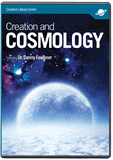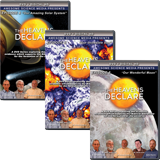
Is the Bible’s Cosmology Borrowed from Pagan Myths?
Cosmology
Did the Bible simply borrow its view of the universe from ancient pagan religions?
Do you remember how Jacob reacted when he first saw Joseph’s bloodstained coat and assumed his son had been killed by a wild animal? He ripped his clothes and put on sackcloth (Genesis 37:34). Job reacted similarly to the news of his children’s deaths, tearing his clothes and shaving his head (Job 1:20). Such behavior may sound odd to us today, but it makes sense within the cultural context.
The ancient Hebrews lived in the Ancient Near East. Knowing about their cultural context helps us better understand many of the unusual things people did in the Bible. Major archaeological discoveries over the past two centuries have greatly aided our understanding of some obscure Bible passages. Unfortunately, it has become fashionable among liberal scholars today to interpret the Old Testament as though all the nations around Israel had exactly the same culture and worldview and the Israelites simply borrowed their ideas from their neighbors. This approach, which in effect rejects God’s inspiration of the Bible, is especially evident in modern interpretations of passages about creation and the cosmos.
If we look closer at these passages, however, we discover the opposite message. The Old Testament displays a prescient knowledge of false religions and their errors. It describes physical reality in a way that highlights errors of other religions while it communicates the truth powerfully—and accurately—to every culture, including our modern scientific era.
Just Another Faulty, Prescientific View?
Most ancient ideas for how the universe developed (cosmologies) placed the earth at the center of the universe. Both the sky and the earth often were supernatural beings (deities). And many times, these deities had warred among themselves before the creation of the world. The bodies of the slain deities became the material for forming the earth and the sky.
In many seminaries today, students are taught to interpret Bible passages as though they are borrowing from ancient cosmologies and myths. For instance, some well-respected Bible scholars now claim that phrases like “the four corners of the earth,” “the pillars of the earth,” and “its top reached to heaven” teach that the earth is flat, is supported underneath with pillars, and has a dome over top, to which the astronomical bodies are attached.
Many liberal scholars point to the Hebrew word for deep in Genesis 1:2 as an example of pagan influence on the Bible. It sounds like the name of the Babylonian goddess Tiamat, who was killed in a war of the gods and whose body was the material out of which the heavens and earth were formed. This similarity is deliberate, but not because of pagan influence. Genesis shows that the ocean was a neutral force created by God, not a personal deity.
References to things like “the ends of the earth” are just idioms, common expressions that refer to distant places where people live, not to the geometry of our planet. We still use the same figure of speech today. But what about the Bible’s supposed allusions to gods of the sea or the vault of the heavens?
What Is the Bible’s View of the Cosmos?
Moses was well-educated in the wisdom of his day (Acts 7:22), yet God inspired what he wrote to oppose those pagan views. Any similarities between Genesis and ancient myths are deliberate efforts to argue against them. Moses was revealing to God’s people the true nature of God and his role in history, while undermining the false myths of surrounding cultures.
So Genesis isn’t describing a war among the gods. In fact, unlike pagan creation stories, it treats the forces of nature as inanimate, under the absolute control of the one true Creator God. He doesn’t need magic or any other outside resources to create the cosmos.
Unlike pagan myths, which describe the gods’ actions in the poetic language of literary epics, Genesis uses the style of historical narrative.
Any allusion to pagan gods of the sea or earth merely mocks these false concepts. Unlike pagan myths, which describe the gods’ actions in the poetic language of literary epics, Genesis uses the style of historical narrative.
The Bible’s creation account gives us some information about cosmology but not a lot of detail. God made an “expanse” around the earth on day two (Genesis 1:6–8), and he filled it with lights (astronomical bodies) on day four (Genesis 1:14–19). The astronomical bodies are physical objects, not gods, as the day four account makes clear. But what exactly is this expanse? And what is the nature of the astronomical bodies?
The Bible never clearly spells out the answers to these questions. So we have some latitude as scientists to discover the answers ourselves, as long as we check our understanding against the teachings of Scripture. We know God has made all things (Colossians 1:16), including things we didn’t discover until recently, such as outer space. Since the expanse is where God put the astronomical bodies, my best understanding is that the expanse is what we today call space.
Genesis 1 describes reality as it appears to our senses, not in reference to its own nature. This is called phenomenological cosmology. As a result, since the stars appear to be embedded in the night sky, Genesis describes them as God putting them “in” the sky. This description of our perception of natural phenomena is completely accurate.
In terms of scientific detail, however, the Bible’s cosmology is sometimes a bit vague. (Note that Genesis is clear on topics that matter, such as the length of each day during creation week, but it doesn’t go into detail on secondary issues like specific details of cosmology). Some people find this suggestion unsettling, but there are good reasons for this. Why would the reader need to know that the earth is a spinning globe that orbits the sun each year? Since this wasn’t the dominant cosmology until recently, it would simply distract from the main message that God, not pagan gods, created everything.
God has revealed enough of cosmology to make his absolute power and authority clear, but the fact that God didn’t give distracting details is a testament to his wisdom.
It is interesting that a few other passages give hints about the all-knowing God’s advanced scientific knowledge of cosmology. For instance, Job 26:7 says that God hangs the earth upon nothing. Ancient cosmologies generally had the earth supported by something, if not the back of Atlas, then the backs of elephants, turtles, or something else. But in Job, there is no support at all. It took science a long time to catch up with this. The Bible’s explanation of the origin and workings of the universe never errs, and it truly does outshine mankind’s ancient cosmologies, even if these biblical truths are sometimes veiled.
Where Did We Go Wrong?
Some people today claim that the Bible teaches that the expanse is a hard sphere or dome, but the Bible doesn’t say this. These interpretations were imported from outside cultures by early Jewish and Christian interpreters and translators, who borrowed from the Greeks’ cosmology. During the first 1,500 years of the New Testament church, most Christians thought that the expanse was a hard sphere (not a dome) surrounding the earth. That is, their views were driven by the common cosmology of their day rather than Scripture.
That is the sort of reasoning that has led to the all-too-common modern conclusion that the Bible teaches a domed, flat-earth cosmology. They follow modern methods of higher criticism in analyzing ancient documents, which deny the supernatural. In their intellectual pride, the higher critics of past centuries assumed that ancient cultures were backward, and they assumed the Bible must be a product of those backward beliefs. The discovery and translation of Ancient Near Eastern documents show that they were not so backward, and the attacks on the Bible were based on false pretenses.
Of course, their analysis completely overlooks the doctrine of the inspiration of Scripture (2 Timothy 3:16; 2 Peter 1:20). The Bible is God-breathed and, hence, true and authoritative. And that includes everything it says about the cosmos.
Answers Magazine
November–December 2019
Don’t look now, but you’re being watched by an amazing variety of magnificent eyes.
Browse Issue SubscribeRecommended Resources

Answers in Genesis is an apologetics ministry, dedicated to helping Christians defend their faith and proclaim the good news of Jesus Christ.
- Customer Service 800.778.3390
- © 2024 Answers in Genesis






